fashionlistings.org
Established 16 years ago, this is THE digital growth hub for fashion-related businesses.
★ Get your own unique FAQ + Selling Points on your profile page
★ be seen by 1000s of daily visitors and win new business
fashionlistings.org Ephemeral Miniblog
Heightened Instinct
Chunks of synthetic leather clung to her arches like exhausted parasites. The heels—seven-inch stilts crafted by a sadist with a degree in fashion—clicked a rhythm older than logic. They shouldn't work. Gravity disagreed. Orthopedic science wept. Yet women wore them, again and again, generation after blistered generation.He watched from behind the glass of his kiosk, where foot-scan diagnostics hummed quietly. Every scan told the same story: collapsed arches, pinched nerves, chronic inflammation. Still, they came. His sister said it wasn't about comfort—it was about signal. The shoes said something to someone. He asked what. She blinked. “I don’t know,” she said. “But not wearing them says something worse.”
He began to wonder if the shoes weren’t a style at all. Perhaps they were a meme, a self-replicating parasite encoded in advertising and adolescent magazines, propagated by whispered envy. A psychic virus, passed through display windows and mother-daughter bonding rituals. He imagined a future where bones adapted, calcifying to match the heel. Style as evolution, pain as tradition.
Loading...
Scene of the Sublime Crime
 Glitter and crime scene tape litter the floor of early 2000s fashion spreads—an assault of low-slung denim, distressed mesh, and an unwavering devotion to asymmetry. Stylists were accessories to the crime, their hands dipped in rhinestones and bad ideas. Models posed like forgotten mannequins in gas station bathrooms, eyes vacant under too much kohl. Fabrics clashed like they had personal vendettas.
Glitter and crime scene tape litter the floor of early 2000s fashion spreads—an assault of low-slung denim, distressed mesh, and an unwavering devotion to asymmetry. Stylists were accessories to the crime, their hands dipped in rhinestones and bad ideas. Models posed like forgotten mannequins in gas station bathrooms, eyes vacant under too much kohl. Fabrics clashed like they had personal vendettas. It was the era of incoherence, of aesthetic anarchy masquerading as edge. Clothes weren’t worn so much as weaponized—jeans that dragged like shame, tops so cropped they whispered apologies. The male gaze held the camera. The female body served the chaos. And somewhere, in the background, a wind machine gasped under the pressure.
Decades later, we look back and say, How brave, when we really mean How did we survive? This was fashion as spectacle, as sabotage. Not liberation. Just confusion with a glossy finish. This wasn’t taste evolving—it was taste on trial, and no one got acquitted.
Loading...
The Crinoline Conundrum
 The crinoline: a skirt so massive, it had its own weather system. Popular in the mid-1800s, this cage-like contraption of steel and horsehair was the Victorian notion of “casual wear.” Imagine going out for a stroll and taking out half a tea shop with your petticoat. If ever there were a garment that needed a warning label and a wide load sign, this was it.
The crinoline: a skirt so massive, it had its own weather system. Popular in the mid-1800s, this cage-like contraption of steel and horsehair was the Victorian notion of “casual wear.” Imagine going out for a stroll and taking out half a tea shop with your petticoat. If ever there were a garment that needed a warning label and a wide load sign, this was it. Women wore it to look more delicate, as if softness could be suggested by dressing like an airborne tent. And yet, paradoxically, there was power in it. Man tries to approach? Try getting past three metres of reinforced hoop. It’s less a dress and more a portable fortress.
What’s wild is that it was less about fashion and more about social choreography—the way one entered a carriage, the required 15-minute pre-sitting routine, the constant risk of being blown away in a mild gust. If clothing is communication, the crinoline screamed: “I exist, and I will take up the entire drawing room.”
Loading...
Chartreuse and Mauve: A Brief Affair
 Chartreuse and mauve are the sort of color pairing that makes décor experts weep quietly into their swatch books. One is the sort of green you'd expect to see oozing from a suspicious flask in a forgotten laboratory, and the other is what happens when purple stays in the bath too long and loses its verve.
Chartreuse and mauve are the sort of color pairing that makes décor experts weep quietly into their swatch books. One is the sort of green you'd expect to see oozing from a suspicious flask in a forgotten laboratory, and the other is what happens when purple stays in the bath too long and loses its verve.And yet—for a bafflingly brief moment just before the sun sets and the light angle distorts reality like a drunk funhouse mirror—it works. The two colors don't so much complement each other as arrive at a temporary peace treaty negotiated by shadows and caffeine. They hum together in a way that makes a man in a turtleneck nod sagely and say, “There’s something there.”
But then it ends. The light fades, a cushion shifts, and suddenly you’re in a room that looks like a Muppet exploded during a wine tasting. The spell breaks. You wonder if it was ever beautiful or if your eyes momentarily gave up in protest.
Beauty, it seems, sometimes just forgets to check with sanity first.
Loading...
The Scarf That Smothered the Room
 It began with a scarf. Blood orange, hand-dyed, gently frayed at the edges. Worn by an off-duty model in Berlin, it made its way to the catwalk three weeks later. Soon, influencers wrapped them carelessly around their necks, letting the ends trail behind like something poetic was about to happen.
It began with a scarf. Blood orange, hand-dyed, gently frayed at the edges. Worn by an off-duty model in Berlin, it made its way to the catwalk three weeks later. Soon, influencers wrapped them carelessly around their necks, letting the ends trail behind like something poetic was about to happen.But then came the sequins. Then the slogans. Then scarves that were so long they dragged along pavements like limp metaphors. They began to define people in ways they hadn’t agreed to. “He’s a scarf guy,” someone would murmur, as if that explained everything.
By the time a men’s magazine declared the scarf “the new identity”, it was over. The scarves were everywhere. In bins. Strangled on café chairs. One fluttered out of a passing Uber like it had finally escaped.
You'd see someone clinging to theirs, eyes darting nervously, as if fearing a question they couldn’t answer: Was it you, or the scarf, who had the personality?
And then they'd take it off.
Loading...
The Spell of Subtle Seasons
 Pumpkin-patterned jumpers materialise in shop windows like Cornish pixies at the first whisper of September. The wool is scratchy, the orange too eager, and yet—year after year—they appear, worn with a kind of ironic pride, as if autumn demanded a uniform.
Pumpkin-patterned jumpers materialise in shop windows like Cornish pixies at the first whisper of September. The wool is scratchy, the orange too eager, and yet—year after year—they appear, worn with a kind of ironic pride, as if autumn demanded a uniform.But rebelling doesn’t require you to retreat to a cave with only your cat and a tin of biscuits for company. There’s a quieter magic in embracing the season without shouting it across your sleeves. Think textures—velvets, knits, soft corduroys in moss green or storm-cloud grey. A scarf the shade of spiced cider that doesn’t announce itself so loudly. A charm of autumn, not a costume.
It’s about dressing like you’ve brewed your own tea blend, not like you’ve wrestled a scarecrow and lost.
You don’t have to look like seasonal merchandise to feel the turn of the year in your bones.
Style, after all, should feel like your own spell—not one lifted from the sales rack at a wizarding joke shop.
Loading...
The Immortal Itch
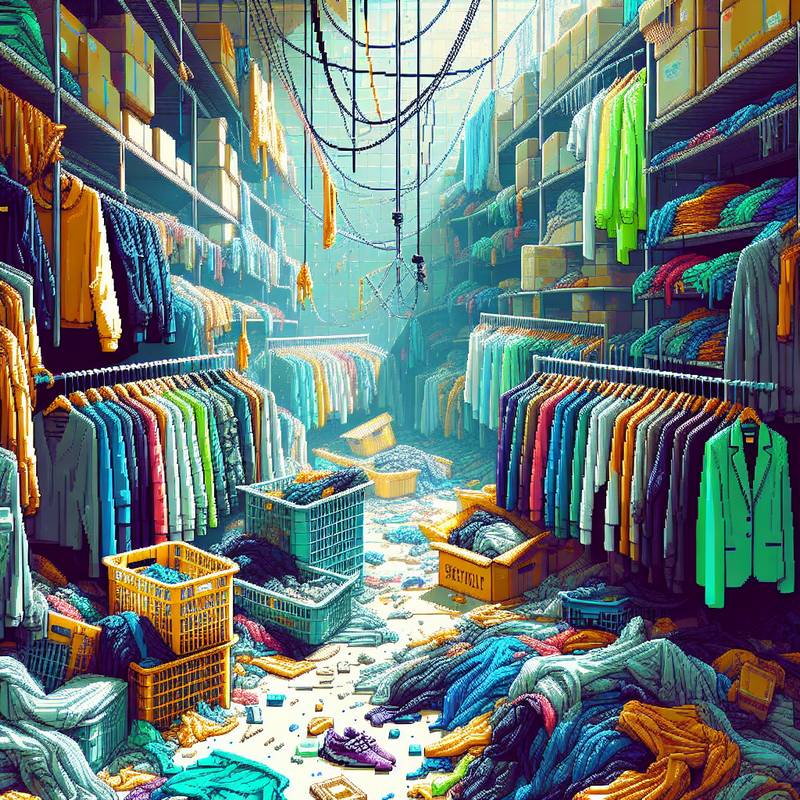 It rustled on the thrift shop hanger like dry leaves in late October. Polyester—sleepy-eyed and plastic-thick, woven from forgotten oil and the sighs of synthetic dreams. You’ve worn it before, haven’t you? That shirt in eighth grade that clung to your skin like a lie. That blazer at your first job interview that sparked each time you shook hands.
It rustled on the thrift shop hanger like dry leaves in late October. Polyester—sleepy-eyed and plastic-thick, woven from forgotten oil and the sighs of synthetic dreams. You’ve worn it before, haven’t you? That shirt in eighth grade that clung to your skin like a lie. That blazer at your first job interview that sparked each time you shook hands. It won’t stop coming back. It waits in department store basements and grandmother closets, whispering, I’m easy, I’m cheap, wear me, love me. But it doesn’t breathe, it traps heat, it hums with the friction of collapsed stars.
You can’t burn it without guilt. It melts, it mocks the fire. It remains. Polyester is the ghost of convenience—man’s attempt to skip nature and fast-forward to permanence. But permanence has a price: sweat you can’t escape, odors that settle like ghosts in the seams, and a foreverness that clings long after memory fades.
We dreamed of a fabric better than the earth gave us. The dream came true. And we’ve been paying for it ever since.
Loading...
The Myth of the Perfect White Shirt
 The crisp white shirt: eternally recommended, perennially misunderstood. It's hailed as the anchor of elegance, the universal solvent for fashion quandaries, yet more often than not, it's seen slumping beneath ill-fitted jackets or gaping awkwardly between buttons as if gasping for freedom.
The crisp white shirt: eternally recommended, perennially misunderstood. It's hailed as the anchor of elegance, the universal solvent for fashion quandaries, yet more often than not, it's seen slumping beneath ill-fitted jackets or gaping awkwardly between buttons as if gasping for freedom. The thing about the white shirt is that it mustn’t merely be worn; it must be befriended, understood, coaxed into place like a skittish cat. Fit is paramount: too billowy and one resembles a disoriented pirate; too snug and we veer into boy-band territory. Worse still is the mismatch with collar stays, or the horror—yes, horror—of improperly ironed cotton flapping like a surrender flag.
Yet at its zenith, the white shirt is a quiet triumph: it doesn't clamor for attention, but glows with the serene confidence of someone who knows their commas from their colons. It elevates without effort. The tragedy? Most people own one and still manage to wear it like a school uniform two weeks past caring.
Loading...
The Tyrant Aphorism
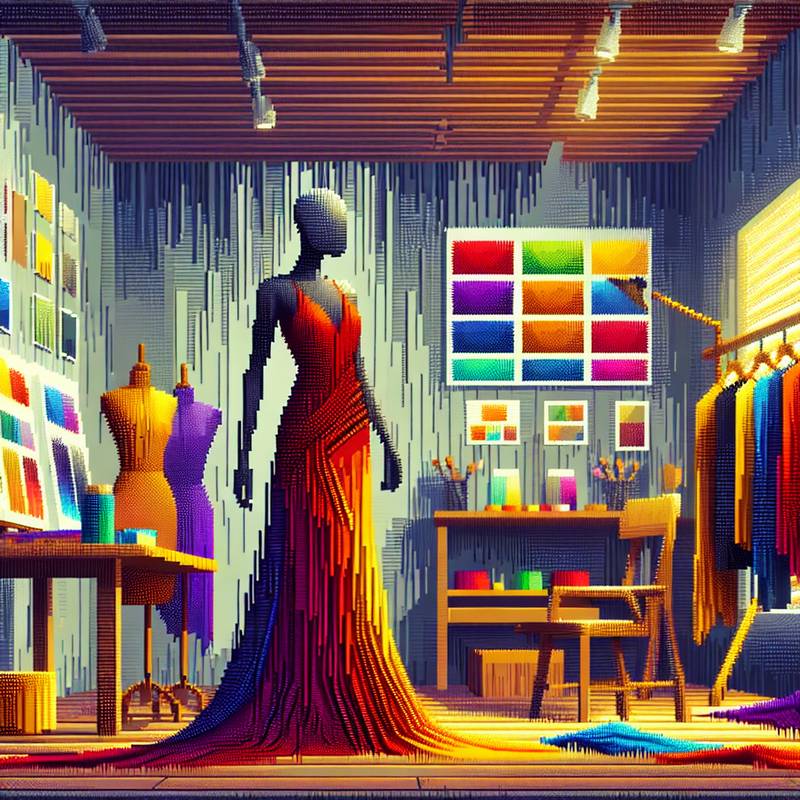 He had this line—“Form is the echo of intention”—which seemed pretentious and/or profound depending on your blood sugar level, and for months it was tacked to the studio wall, hovering over mood boards and hand-dyed swatches like a minor deity. The problem was that once he’d said it (and worse, started believing it), the clothes began to suffer. Sleeves got longer, inexplicably—like they were reaching for something—while ruching turned cryptic; one dress had a zipper that spiraled in a way that made you feel paranoid. Instead of garments, you got arguments in silk. Intention became so heavy it warbled the fabric's ability to simply hang. The collection bombed, obviously. No editors clapped. But in retrospect it wasn’t ego, exactly. It was belief. The kind of belief that makes you think “intention” is something you can transmit through tulle, like radio waves or certain kinds of grief. Which maybe you can. But intention without attention becomes noise. Or worse: abstraction with nice seams.
He had this line—“Form is the echo of intention”—which seemed pretentious and/or profound depending on your blood sugar level, and for months it was tacked to the studio wall, hovering over mood boards and hand-dyed swatches like a minor deity. The problem was that once he’d said it (and worse, started believing it), the clothes began to suffer. Sleeves got longer, inexplicably—like they were reaching for something—while ruching turned cryptic; one dress had a zipper that spiraled in a way that made you feel paranoid. Instead of garments, you got arguments in silk. Intention became so heavy it warbled the fabric's ability to simply hang. The collection bombed, obviously. No editors clapped. But in retrospect it wasn’t ego, exactly. It was belief. The kind of belief that makes you think “intention” is something you can transmit through tulle, like radio waves or certain kinds of grief. Which maybe you can. But intention without attention becomes noise. Or worse: abstraction with nice seams.Loading...
The Veneer of Sanity
The hair’s neat. The coat’s pressed. A figure emerges with the lacquered calm of a woman whose therapist thinks she’s cured. She smiles. Too widely. What you’re seeing is a curated catastrophe—madness in a Dior sheath.What the well-groomed madman knows, and the world forgets, is that disorder draws suspicion. Sanity, meanwhile, has a uniform: clean collar, dry eyes, a watch that runs on time. The trick is in the varnish. You must look like you’ve been somewhere. Not heaven or hell, but daintily near the edge—then reversed out like a Bentley.
So she matches her earrings. So he carries a leather briefcase to an invisible job. They’ve mastered the semaphore of sanity: tailored clothes, decisive gait. Inside, the wiring’s sparking. But no one notices. We are hypnotised by polish.
Perhaps that's the real performance of the age—not brilliance, not kindness, but composure. For all our talk of authenticity, we still trust the moored over the marooned. It’s theatre. It’s fraud. It’s survival.
Loading...
The Blazer Blunder
 The blazer: that noble, oft-misunderstood staple of the so-called well-dressed. It hangs in wardrobes like a relic from a more formal age, as if secretly mourning the death of Savile Row etiquette. Supposedly versatile, it’s worn with the hesitance of someone trying to pet a wasp—too tight, too boxy, or paired with trainers in a tragic attempt at ‘smart-casual’. The blame doesn’t lie with the garment but with our insistence on styling it with all the grace of a rehearsal dinner in Crocs.
The blazer: that noble, oft-misunderstood staple of the so-called well-dressed. It hangs in wardrobes like a relic from a more formal age, as if secretly mourning the death of Savile Row etiquette. Supposedly versatile, it’s worn with the hesitance of someone trying to pet a wasp—too tight, too boxy, or paired with trainers in a tragic attempt at ‘smart-casual’. The blame doesn’t lie with the garment but with our insistence on styling it with all the grace of a rehearsal dinner in Crocs.A blazer should skim, not suffocate; it ought to suggest structure without approaching straitjacket territory. Too many wear it as armour, buttoned high and rigid, when it should be a frame—graceful scaffolding for the art of self-presentation. The devil, as they say, is in the tailoring. Sleeves should end just above the wrist bone, revealing the faintest touch of shirt cuff, not flap about like sails in a troubled breeze.
Master the blazer, and you master a kind of modern magic: elegance disguised as ease.
Loading...
The Baseball Cap Crimes
 The baseball cap is not your friend. Not the actual cap – which, when worn by an actual baseball player doing actual sports, is fully justified. No, the problem is its diaspora into every realm of civilian life, where it flattens character and squats uninvited on heads that deserve better.
The baseball cap is not your friend. Not the actual cap – which, when worn by an actual baseball player doing actual sports, is fully justified. No, the problem is its diaspora into every realm of civilian life, where it flattens character and squats uninvited on heads that deserve better.It doesn’t matter how carefully chosen your jacket is, or how artfully frayed your jeans are – that cap silences everything else your outfit is trying to say. Worse, it implies you got dressed in the dark and only remembered your head at the last minute.
This isn’t an attack on comfort. There are hats that look good and feel right. But the baseball cap hovers there mutely, heroically bland, as if banality were a style choice. It pretends to understate when what it really does is erase. It mumbles something about chill vibes and then proceeds to suck the joy out of a perfectly good look.
Take it off. Show us your face. Trust your hair.
Loading...
The Unsung Power of Granny Panties
High-waisted underwear. That’s the hero we don’t deserve but absolutely need. I’m talking about those belly-button-hugging briefs that your grandma probably wore while raising five kids on one income and still had the time to serve looks at church on Sunday.They don’t roll down when you bend over, they don’t disappear up your butt when you sneeze, and they have the nerve—the audacity—to make you feel secure. Like a gentle, cotton-laced reminder that maybe you are holding your life together. You ever try yelling at your kids with your lower intestines safely cradled? Game-changer. You get a different kind of authority when your underwear supports you emotionally.
Low-rise string wannabes can’t do that. Those are fabric lies. High-waisted underwear is the one article of clothing that doesn’t gaslight you. It tells you: You are doing your best, Michelle. You deserve coverage.
And when you pair ‘em with sweatpants, it’s like your pelvis finally made peace with gravity.
Loading...
How to Wear Something Bold Without Looking Like You Lost a Bet
 Sequins at brunch? Leopard print pants? Bright red leather anything? Yes, yes, and yes. But here’s the trick: you wear the bold thing like it was your idea. Not your stylist’s. Not your roommate’s. Yours. The whole vibe is “I know this is a lot, and I love that for me.”
Sequins at brunch? Leopard print pants? Bright red leather anything? Yes, yes, and yes. But here’s the trick: you wear the bold thing like it was your idea. Not your stylist’s. Not your roommate’s. Yours. The whole vibe is “I know this is a lot, and I love that for me.”Start with one centerpiece. If the pants are wild, keep the top chill. Don’t let your outfit turn into an attention-seeking group project—one star per look, okay? Also, fit is everything. If it hugs you in all the wrong places, even the boldest print can’t save it. Think Beyoncé energy, not “I had five minutes to get dressed.”
And most importantly, pair confidence with kindness. You can’t strut in gold metallic boots and then act superior about it. That’s how fashion becomes a costume instead of a statement. Bold is best when it feels like an extension of you—not a mask or a prank.
Wear it like you're the inspiration for its creation. Because maybe you are.
Loading...
The Button of Mental Balance
 It is a commonly overlooked truth that the placement of a jacket’s top button is more revealing than any diary entry or pillow-soggy confession. Just one inch too high, and you look like a man permanently reaching for a thought he’ll never quite recall. Too low, and you seem faintly apologetic for existing in three dimensions.
It is a commonly overlooked truth that the placement of a jacket’s top button is more revealing than any diary entry or pillow-soggy confession. Just one inch too high, and you look like a man permanently reaching for a thought he’ll never quite recall. Too low, and you seem faintly apologetic for existing in three dimensions.The proper positioning—midway between the shoulder seam and the navel—is an architectural marvel, a kind of emotional plumb line. It aligns not just the fabric, but the very idea of you. You stand differently. You nod with more conviction. People listen, not out of politeness, but because your button insists that you’ve edited your internal monologue to a tolerable length.
Therapists, of course, will help you find the source of your discontent. A good tailor, on the other hand, removes the need to explain it in the first place. You don’t need to say you’re fine. The jacket says: 'Sorted. That top button, friend—it’s the clasp that holds together the fragile illusion of your coherence.
Loading...
The Blazer: Misunderstood and Misworn
 The blazer stands tall and proud in the pantheon of “essential items,” beloved by stylists and cursed by wardrobes. Supposedly, it transforms the wearer into a paragon of effortless sophistication. In reality, it’s too often worn with the wilting despair of a schoolboy at a wedding or a sales manager two drinks deep into the office party.
The blazer stands tall and proud in the pantheon of “essential items,” beloved by stylists and cursed by wardrobes. Supposedly, it transforms the wearer into a paragon of effortless sophistication. In reality, it’s too often worn with the wilting despair of a schoolboy at a wedding or a sales manager two drinks deep into the office party. People rarely grasp its true alchemy: a blazer isn’t just a jacket with delusions of grandeur. It demands attentive pairing—not with jeans that gave up three washes ago, and certainly not with trainers that think “minimalist” means “filthy.” The shoulders should suggest confidence, not crime; the fabric ought to flirt with your frame, not bully it.
One suspects the crux of the matter is that the blazer, like all great ideas, requires care, curiosity, and a dab of panache. It sits in closets whispering potential, but is so often muttered into mediocrity. Dress it well, or not at all.
Loading...
Socks: The Quiet Genius of Wardrobes
 You ever notice how no one talks about socks? I mean, we spend hours debating jackets and trousers and all that, but socks? Quiet little legends. They’re down there doing all the work – absorbing your sweat, keeping your toes civilized, stopping your shoes from smelling like a taxi driver’s glove compartment – and they never ask for thanks.
You ever notice how no one talks about socks? I mean, we spend hours debating jackets and trousers and all that, but socks? Quiet little legends. They’re down there doing all the work – absorbing your sweat, keeping your toes civilized, stopping your shoes from smelling like a taxi driver’s glove compartment – and they never ask for thanks. A good pair of socks can save your day. Get one with a bit of weight, a bit of stretch, and suddenly your shoes fit better, you're walking taller, and you're not distracted every five minutes by blisters the size of grapes. And yet, people will spend 200 quid on a coat but wear novelty socks with holes in 'em, like their feet are doing stand-up.
Invest in socks. Proper ones. It's not glamorous, but neither is trench foot. They’re the unsung heroes. Literally below you, all day, holding the line. Respect.
Loading...
The Daring Costume of Conviction
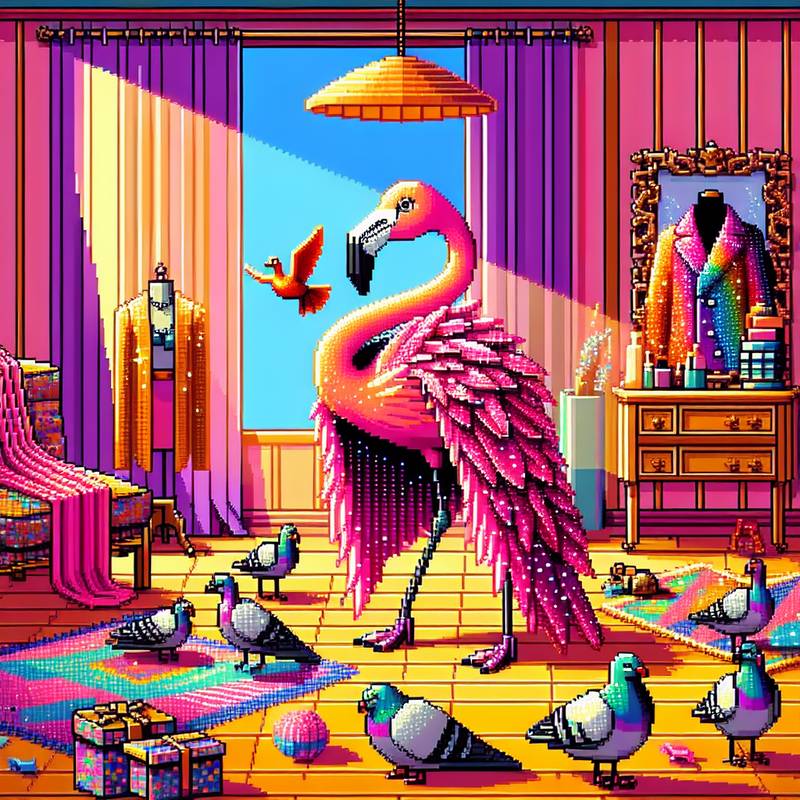 A flamingo in a room of pigeons must walk as if it owns the floor. The same rule applies when one chooses to wear something audacious—be it a velvet suit in a hostile daylight or a hat with more architecture than Versailles. The secret lies not in the garment, but in the gait. Clothes are merely declarations; it is the manner that makes them believable.
A flamingo in a room of pigeons must walk as if it owns the floor. The same rule applies when one chooses to wear something audacious—be it a velvet suit in a hostile daylight or a hat with more architecture than Versailles. The secret lies not in the garment, but in the gait. Clothes are merely declarations; it is the manner that makes them believable. Never apologise with your posture. Confidence should not be worn like a borrowed coat. Look as though the dénouement of your life depends on this very ensemble and that you would be rather bored by anything less.
Accessorise with intention—as a painter dabs the final stroke. One eccentric detail is charming; three are a manifesto. And remember, true elegance whispers, even when it’s dressed in sequins.
To wear the bold is to court the sublime risk of being remembered. One must always dress as though one's soul were watching.
Loading...
Elegance in the Abyss
 A blazer over rainbow pajamas, espresso in one hand, conch shell in the other—perception is a jazz solo in a crowded elevator. We curate chaos under a veneer of corduroy. It's pure symphony. Button it up tight, but let your eyes scream Dadaism in Morse code.
A blazer over rainbow pajamas, espresso in one hand, conch shell in the other—perception is a jazz solo in a crowded elevator. We curate chaos under a veneer of corduroy. It's pure symphony. Button it up tight, but let your eyes scream Dadaism in Morse code.People whisper, 'They've got it together,' while your socks are from alternate timelines and your calendar is just a drawing of a cat. See, it's not about hiding the entropy. It’s about making entropy your stylist.
“Put-together” is just semiotic origami. Take your meltdown and wrap it in a cashmere scarf. Smile like your thoughts aren’t five raccoons in a trench coat arguing about existentialism.
The trick? Confidence. Not the loud kind. The kind that hums like a synthesizer under your breath while you recite sandwich ingredients like mantras. Be the paradox. Own your mess with surgical precision.
Unhinged isn't broken. It's just the door swinging open to a new dimension in high heels and holographic lip gloss.
Loading...
Dressed To Confuse
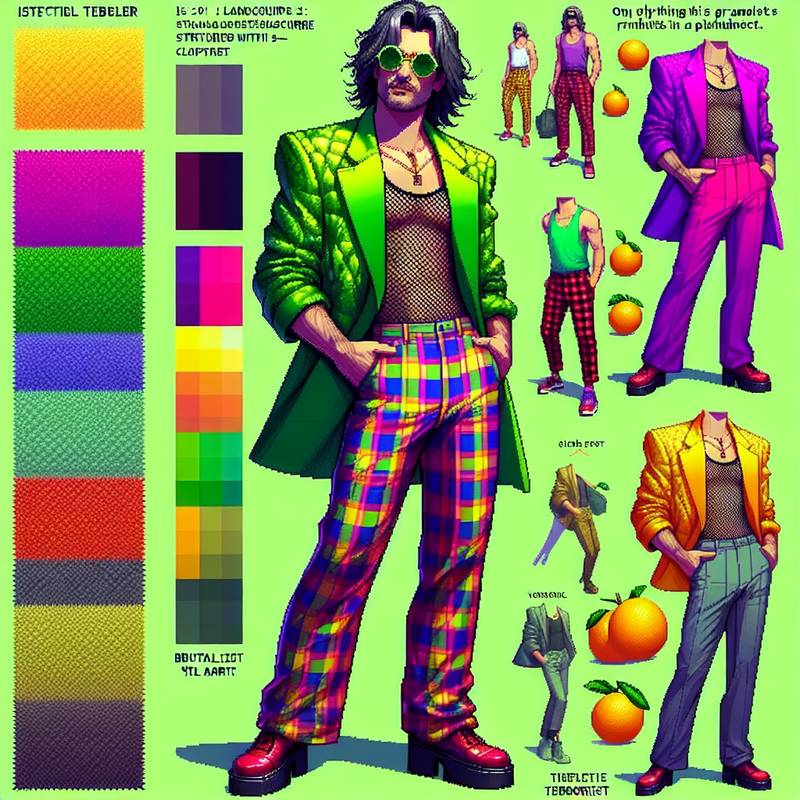 You see these celebrities showing up in outfits that look like they lost a bet with a wallpaper factory. Take this guy—he’s got on a blazer made of crushed velvet, neon green. Velvet, folks. That’s a fabric designed for fainting women in 1860s parlors, not 2024 red carpets. Underneath? A mesh tank top. Mesh! That’s not clothing, that’s a screen door. The only thing it’s holding out is dignity.
You see these celebrities showing up in outfits that look like they lost a bet with a wallpaper factory. Take this guy—he’s got on a blazer made of crushed velvet, neon green. Velvet, folks. That’s a fabric designed for fainting women in 1860s parlors, not 2024 red carpets. Underneath? A mesh tank top. Mesh! That’s not clothing, that’s a screen door. The only thing it’s holding out is dignity.Then we hit the pants—plaid, bright red, tighter than a bank vault. He’s walking around like he’s smuggling grapefruits in a picnic blanket. And the shoes—platforms that look stolen from a disco-era Frankenstein. He’s three inches taller and twice as confused.
But here’s the twist: millions follow this. They see that and think, that’s bold! No, it’s not bold—it’s textile terrorism. Somewhere, a tailor is weeping because a spool of fabric died for this mess. It’s not fashion—it’s performance art with a concussion.
Loading...
Chartreuse and Consequences: A Fashion Autopsy
She walked in like she owned the HomeGoods clearance section. I mean, bold move—head-to-toe lime green, like a tennis ball had a baby with a highlighter and raised it on daytime TV. The blazer? Structured like it was made from envy and regret. The pants were screaming “accountant at Burning Man.” And those heels—clear plastic, chunky, Cinderella-went-to-Coachella shoes—not glass slippers, more like a Tupperware nightmare.Her necklace looked like it had beef with her neckline—giant, rhinestone-drenched, probably audible from space. Accessories shouldn’t look like they're about to file a restraining order on your outfit. But this woman, she committed. Head held high, like her earrings didn’t look like they were borrowed from a decorative wind chime.
Still, I admire the guts. You wear something that loud, you either hate subtlety or lost a bet with your stylist. And that kind of confidence? That’s couture. The fashion equivalent of a karaoke rendition of I Will Survive—out of tune, but unforgettable.
Loading...
The Lime and the Flame
 It is a truth rarely acknowledged that lime green and burnt orange, when seen together, appear to be the result of a bet between two colours who had just lost a game of taste to mauve. They clash. They jar. They look like they were picked out by a committee of parrots. And yet, somehow, on some days, in certain lights, in the presence of specific types of music and a strong possibility of gin, they work. A scarf, perhaps, that makes its wearer look like a fashionable warning sign. A room that manages to feel like both a tropical resort and a slight hangover.
It is a truth rarely acknowledged that lime green and burnt orange, when seen together, appear to be the result of a bet between two colours who had just lost a game of taste to mauve. They clash. They jar. They look like they were picked out by a committee of parrots. And yet, somehow, on some days, in certain lights, in the presence of specific types of music and a strong possibility of gin, they work. A scarf, perhaps, that makes its wearer look like a fashionable warning sign. A room that manages to feel like both a tropical resort and a slight hangover. But then—time passes. Fashion changes. The scarf unravels. The room is repainted by someone with a grudge and a voucher for beige. The magic goes, and what's left is a memory of when chaos briefly pretended to be style. Which is all colour ever is, really: a temporary agreement between photons and vanity.
Loading...
The Thread That Would Not Die
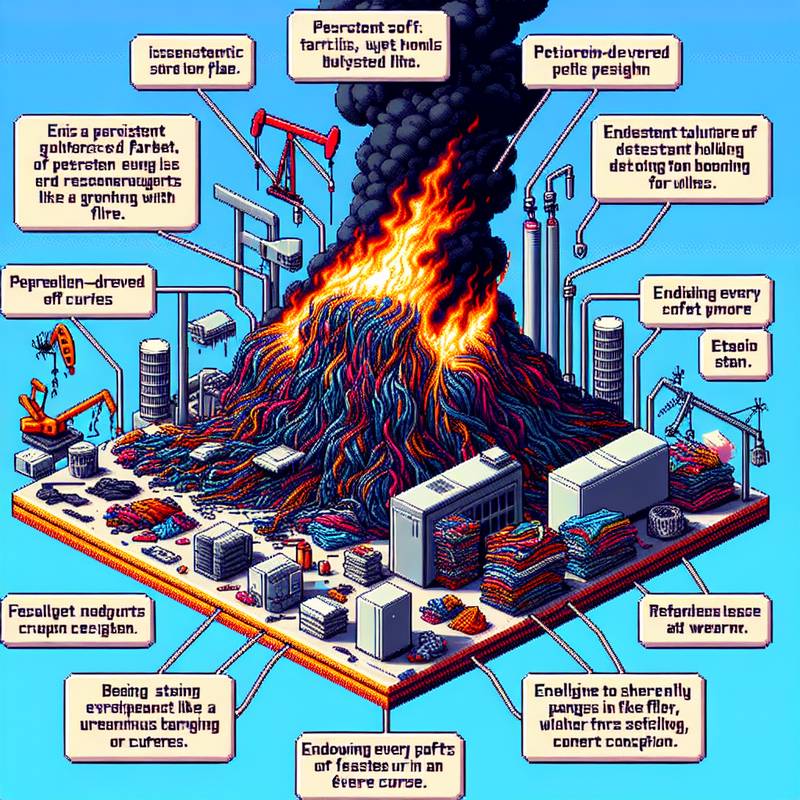 Lurking in soft folds like a spider in velvet, the cursed weave shows up again—polyester, the petrochemical revenant. A stitch in time that never heals, synthetic and eternal, sealed in a covenant with entropy. It is the fabric of forgotten office chairs and the unyielding embrace of nightmarish uniforms, where sweat refuses to die, merely loops through cycles of entrapment.
Lurking in soft folds like a spider in velvet, the cursed weave shows up again—polyester, the petrochemical revenant. A stitch in time that never heals, synthetic and eternal, sealed in a covenant with entropy. It is the fabric of forgotten office chairs and the unyielding embrace of nightmarish uniforms, where sweat refuses to die, merely loops through cycles of entrapment. You don’t wear polyester; it wears you, whispering through static hums the echo of crude oil's birth-pangs. Wash it, burn it, fold it into drawers like a curse folded in parchment—but it returns. In parkas, in curtains, in the once-holy cotton blend now tainted by its ghostly sheen. It resists decay; even moths know better. What man could not die, let fabric endure.
Every thread contains a memory not yours—a haunted garment, woven from the same black threads of oil that powered the machines of war. It mocks time, resists flame, welcomes landfill like a throne and leaves no honest dust behind.
You’ll see it again. It always comes back.
Loading...
The Fabric That Forgot How to Die
 Polyester waits. It doesn’t breathe, it doesn’t rustle like silk or fray like linen—it stifles. A fabric forged not in loom or meadow but in chemical vats and factory shadow, it clings too closely in summer and crackles in dry cold like a whispering ghost. You didn’t invite it in, yet there it is—lining the jacket your aunt gave you, sneaking into the blend of your favourite socks.
Polyester waits. It doesn’t breathe, it doesn’t rustle like silk or fray like linen—it stifles. A fabric forged not in loom or meadow but in chemical vats and factory shadow, it clings too closely in summer and crackles in dry cold like a whispering ghost. You didn’t invite it in, yet there it is—lining the jacket your aunt gave you, sneaking into the blend of your favourite socks. It repels water, which sounds like a virtue, until you realise it repels memory too. No scent lingers, no softness earned with age. A coat of polyester is ageless in the wrong way—unmoved, unaged, unyielding. It lasts forever, the way curses do.
It returns in the blue uniforms of the underpaid, in the itchy seatbelt strap that gnaws at your collarbone, in the cheap red flags of school sports day. It's an echo of all the compromises we've made for ease, for permanence, for synthetic certainty.
You feared goblins once. They were charmingly direct. But polyester? It waits, and it wraps, and it never, ever leaves.
Loading...
The Fedora Fallacy
 The fedora: a hat so burdened with unfortunate connotation, it practically sags under the weight of its own infamy. Originally crafted to crown heads with distinction, it now mostly signals a tragic overestimation of one's own suaveness. Think Humphrey Bogart, but more humid and desperately self-aware.
The fedora: a hat so burdened with unfortunate connotation, it practically sags under the weight of its own infamy. Originally crafted to crown heads with distinction, it now mostly signals a tragic overestimation of one's own suaveness. Think Humphrey Bogart, but more humid and desperately self-aware. What began as a modest brim has become the male equivalent of punctuation jewellery — unnecessary, overconfident, and alarmingly misapplied. A fedora in the wild rarely elevates. Instead, it draws the eye and not in the way its wearer intends. It is the fashion equivalent of turning up with a monocle and assuming everyone’s just too afraid to say how brilliant you look.
This hat doesn’t whisper elegance — it announces itself, loudly, in the key of misguided. It’s the accessory that insists on being noticed and, in doing so, unravels any remote semblance of effort made elsewhere. If your outfit were a soufflé, the fedora is an unexpected bowling ball.
Loading...
The Unsung Majesty of the Undershirt
 You ever wear an undershirt and think, “Oh my God… I’ve been raw-dogging fabric this whole time”? Because that’s the moment. That’s the awakening. The humble undershirt—white, stretchy, possibly purchased in bulk next to laundry detergent—is the secret scaffolding of adulthood. It absorbs your sins, shields your torso from betrayal by overconfident deodorant, and smooths you out like Photoshop for your torso.
You ever wear an undershirt and think, “Oh my God… I’ve been raw-dogging fabric this whole time”? Because that’s the moment. That’s the awakening. The humble undershirt—white, stretchy, possibly purchased in bulk next to laundry detergent—is the secret scaffolding of adulthood. It absorbs your sins, shields your torso from betrayal by overconfident deodorant, and smooths you out like Photoshop for your torso.People think it’s just a formality. NO. It’s a tuxedo for your skin. It whispers, “I respect this outer shirt too much to let it touch me directly.” It’s the middle man of hygiene and dignity. Without it, dress shirts stick to you in ways you only see in horror movies. With it, you’re like, “Oh, I give a tiny little damn about how I exist in the world.”
And it’s not flashy. It’s not out there trying to win awards. It just shows up every day like, “Don’t worry, I got you.” That’s not a garment. That’s a friend.
Loading...
Fashion Crime Scene: Frosted Lipstick & Too Many Belts
 Sequins were everywhere. Not like “a fun night out” sequins, but more like “someone murdered a disco ball and used its remains as a scarf” sequins. I walked into the archives of early 2000s fashion photography and felt like CSI: Bedazzled. Every model looked vaguely surprised, as if they’d just realized they were wearing three belts at once—with none of them holding up pants. Because pants were optional. Skirts with leggings. Leggings under cargo shorts. Crime scene tape should have cordoned off entire photo shoots.
Sequins were everywhere. Not like “a fun night out” sequins, but more like “someone murdered a disco ball and used its remains as a scarf” sequins. I walked into the archives of early 2000s fashion photography and felt like CSI: Bedazzled. Every model looked vaguely surprised, as if they’d just realized they were wearing three belts at once—with none of them holding up pants. Because pants were optional. Skirts with leggings. Leggings under cargo shorts. Crime scene tape should have cordoned off entire photo shoots.Makeup resembled a Crayola factory explosion—there were so many frosted lips and glittery eyelids I briefly wondered if everyone had conjunctivitis. The lighting? Overexposed enough to suggest that God himself operated the flashbulb. And the poses. Limbs akimbo like someone said, “Pretend you're falling into a beanbag chair filled with regret.”
It wasn’t just fashion. It was a coordinated aesthetic felony committed by stylists, photographers, and one rogue hairstylist with a crimper and a dream. We all survived it, barely. But our yearbook photos remain...unforgiven.
Loading...
The Tyranny of the Lanyard
 It’s the lanyard. That spectral noodle of fabric round your neck, flapping like a limp wizard’s wand. The lanyard thinks it's the VIP of accessories, but it's more clingy than a sock in static. It doesn’t follow colour palettes or style rules—it imposes its grim will on even the strongest of outfits. You could be wearing a bespoke velvet cape and chrome brogues forged in a star’s dying breath, but slap a lanyard on it and suddenly you're Craig from Accounts who’s lost his swipe card... again.
It’s the lanyard. That spectral noodle of fabric round your neck, flapping like a limp wizard’s wand. The lanyard thinks it's the VIP of accessories, but it's more clingy than a sock in static. It doesn’t follow colour palettes or style rules—it imposes its grim will on even the strongest of outfits. You could be wearing a bespoke velvet cape and chrome brogues forged in a star’s dying breath, but slap a lanyard on it and suddenly you're Craig from Accounts who’s lost his swipe card... again.It dangles. It announces. It thwacks against your chest like a rubber judge's gavel of beige bureaucracy. Even if it’s neon pink with glitter, it still whispers the saddest of truths: I am tethered to a system. There’s no mystery in it. No flair. Just that plastic coffin of an ID, grinning up at everyone like an awkward ghost.
Want to elevate your outfit? Tuck it away. Better yet, let your aura do the talking. Lanyards are for laminates, not legends.
Loading...
The Silent Majesty of Suspenders
 Suspenders. Yeah. Suspenders are the grandparents of confidence and utility, quietly holding up your dignity with zero fanfare. Belts scream, “Look at me, I’m controlling waist chaos with force!” Suspenders just whisper, “We’ve got this,” and go back to binge-watching old detective shows with a glass of room-temperature bourbon.
Suspenders. Yeah. Suspenders are the grandparents of confidence and utility, quietly holding up your dignity with zero fanfare. Belts scream, “Look at me, I’m controlling waist chaos with force!” Suspenders just whisper, “We’ve got this,” and go back to binge-watching old detective shows with a glass of room-temperature bourbon.They're the tuxedo's best-kept secret and the middle manager of fashion—overlooked, underappreciated, but keeping structural integrity intact. And the comfort? It’s like your pants are being gently encouraged upward by optimistic ghost hands. No belly pinch. No cutting a canyon into your waist like belts do after a big lunch. Just a fluid, floating sense that maybe gravity isn’t that big a deal after all.
You wear suspenders, and somewhere deep in your soul, a jazz saxophone starts playing. Not loudly. Just enough that you walk into a room and people sense you’ve either solved a murder or made the best sandwiches at a funeral.
Suspenders don’t shout style. They assume it.
Loading...
The Sleeve That Listens
You can judge a man not by his shoes, nor his tie, nor even the way he folds a napkin in mixed company, but by the curve of his jacket sleeve. Most people don't notice it—they're dazzled by lapels or distracted by buttons. But the sleeve’s gentle arc, following the natural bend of the arm, is a triumph of quiet engineering. It whispers, 'Here is a man who plans to move.Therapy, for all its virtue, rarely addresses the tyranny of ill-fitting garments. A flat, lifeless sleeve tugs at the shoulder and burdens the soul. A tailored curve, however, allows the limb its dignity. It doesn’t judge you when you gesture wildly at dinner or reach for the last sausage on the buffet. It anticipates your needs.
We all crave understanding, but sometimes what we truly require is a sleeve that gets us. Once your jacket moves with you—no resistance, no crumpling—you’ll never again tolerate a stiff relationship. Or worse, off-the-rack.
Loading...
fashionlistings.org (c)2009 - 2025